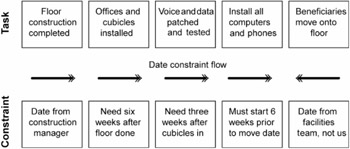7.10 Adjusting Your Schedule
|
| < Day Day Up > |
|
7.10 Adjusting Your Schedule
In many of these cases, midstream corrections are required in terms of changing dates. On a previous project, we had a new building of a few dozen floors that had to be wired for voice and data. The schedule called for doing two floors at a time as follows:
-
Install two local area network (LAN) switches per floor.
-
Install LAN and analog cards in each switch.
-
Cross connect and patch data jacks to assigned switch ports.
-
Cross connect and patch analog jacks to assigned switch ports.
-
Test throughput at each connected jack.
-
Document all connections, and turn these as-builts over to network operations.
The implementation schedule for this process was dictated by two dates. The first was the date at which time the construction company handed the floor over to our telecom department to perform the preceding tasks. The second date was the lead time required by the team that would come in after telecom to install computers and test them prior to the new users moving into the building. The move dates had been set a year before we started scheduling the technology implementation and could not be changed. Graphically, the implementation plan looked like the one in Exhibit 10.
Exhibit 10: Date-Constrained Tasks Impacted by Slippage

The project team built an elegant schedule based on this logic and validated the furniture turnover dates with the general contractor's project manager. This was done 6 months in advance of the start of floor turnovers. Of course, as we got near the starting line, the construction manager advised us that his turnover dates for floors and furniture date would slip significantly. With our move-in dates intractable, however, this meant we would be squeezed on the telecom and technology installation time side of the schedule. We, in turn, forced a recommitment from the construction side, so that the following durations and dependencies were renegotiated. Both the original and adjusted durations are documented in Exhibit 11. It also shows the new scheduling strategy we negotiated for each of the dozens of floors with which we had to work.
Exhibit 11: Adjusted Completion Schedule by Floor and Major Task
| Task | Original Duration | Adjusted Duration |
|---|---|---|
| Furniture installation | 6 weeks | 4 weeks |
| Telecom installation | 3 weeks | 2 weeks |
| Technology installation | 6 weeks | 3 weeks |
| Net change in total | 15 weeks | 9 weeks |
All parties had to increase staff levels or resort to overtime to accommodate this more aggressive schedule. This example illustrates the process you must follow as you learn or presume that delays are pending. It is crucial that you understand your schedule, particularly the critical path and key dependencies, before entering any such negotiations. That way, you can protect your resources and deliverables as much as possible. Being late does not always matter, but reacting poorly to significant slippage can be disastrous.
|
| < Day Day Up > |
|
EAN: 2147483647
Pages: 231